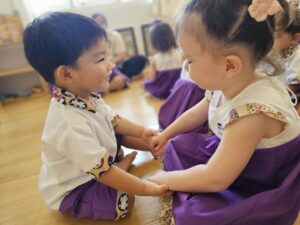4 Beautiful Locations Islandwide
Montessori materials are designed to match the natural inclinations and developmental needs of children. They encourage self-correction and tap into a child’s inherent motivation to learn and improve. Concrete and tangible, they provide children with objects to touch and manipulate in order to internalise abstract concepts. These materials are often made up of small, intriguing objects that pique a child’s curiosity and allow them to playfully recreate the world around them.
“The study of grammar is to language what the study of anatomy is to science. By studying grammar, we become better writers and readers.”
Lori Bourne, Montessori for Everyone

The Montessori Grammar Farm is a perfect example of these qualities coming together. Not only does it allow children to practice building simple combinations of words and phrases, it also provides an opportunity for the younger children to build on their vocabulary through interactions with the objects.
More commonly referred to as ‘The Farm’, this is a set of instructional materials used to teach grammar concepts in the Montessori classroom, laying the roots for good communication, reading comprehension, writing, speaking, story-telling and more. Children are given opportunities to interact with the materials to learn about the different parts of speech: nouns, verbs, adjectives, and articles and how they are used in sentences. It provides a setting for activities of language enrichment, grammar, reading, and eventually writing. The Farm consists of a barn, people, animals, fences, a tractor, and many more. This fun material introduces grammar by using characters and labels, making it very interactive and interesting for the children. Other variations of this type of material include dollhouses or city plazas.
Strong grammar skills are essential for young children, and in particular, help our students as they transition to higher levels of education, such as the Singapore Ministry of Education Primary 1 syllabus and international schools.

The children are invited to investigate the Montessori grammar farm model that includes animals, objects, and label cards that correspond to each figure. By utilising The Farm material, the children are able to develop their language skills by constructing basic word combinations, identifying the objects, and vocalising their sentences or phrases. Despite not having been introduced to the parts of speech yet, the label cards are colour-coded to match the system used when teaching about verbs, nouns, articles, and other parts of speech.

Through the use of a material that stimulates their interest and curiosity, the children’s comprehension of formal written language and its principles can be improved without them being aware that they are “practising their grammar.”
The Montessori Grammar Farm in Action
The Nursery to Kindergarten Montessori classroom provides an opportunity for early grammar instruction, which can be facilitated through materials like The Farm.
After learning about the function of nouns, a child can apply this knowledge by labelling the various nouns found on the farm, such as sheep, goat, farmer. Similarly, a child who has received lessons on articles and adjectives can distinguish between different items or use more descriptive language, such as identifying the brown cow versus the black cow or a fluffy, white sheep. Finally, a child who is practicing with verbs can add some action by placing cards that describe activities such as planting tiny seeds: The farmer plants tiny seeds.

By using this material, children can enhance their reading skills by practicing reading words within a given context, comprehend the role of different words, and develop the groundwork for reading and writing creatively. Once children have gained an initial understanding of grammar through sensorial activities, they can proceed to comprehend it at a more profound level. They now have the tools and confidence to master literacy, indispensable knowledge as they move from preschool to primary school, and beyond!
Addendum
Grammar in Montessori
Montessori’s approach to grammar assigns a specific shape and colour to each part of speech to convey its unique significance. For instance, the Noun is depicted as a black pyramid, which represents the solidity and immobility of one of the earliest human structures. The colour black symbolizes carbon, which is thought to have been the first mineral discovered by humans. This visual cue suggests that nouns, or words that denote people, places, or things, may have been among the earliest words spoken by humans. Conversely, the Verb is represented by a red sphere, evocative of the shape and energy of the sun, which sustains life. The verb animates objects and imbues them with movement, much like the sun animates all living creatures.
Dr. Montessori designed a series of Grammar materials that bring this work to life. To make learning grammar more engaging and memorable, each part of speech is presented through an interactive story or game. For instance, when teaching adjectives, the teacher might gather a group of children and ask them to fetch a book for her. As the children return with different books, the teacher rejects them one by one, claiming she was thinking of a different one. After several unsuccessful attempts, the children realize they need more information to fulfill the teacher’s request. At this point, the teacher explains that when there are many options, we need to use more precise language. She then specifies, “I want the small book with the green spine,” illustrating how adjectives can modify nouns to provide additional details and specificity.
Further Reading:
How To Introduce English Grammar With A Farm – Jojoebi
Grammar in Montessori language — The Wonderful World of Montessori (wonderfulmontessori.com)
Grammar Materials Bring Language to Life – Montessori for Everyone Blog
Phonetic Animal Farm — The Wonderful World of Montessori (wonderfulmontessori.com)








